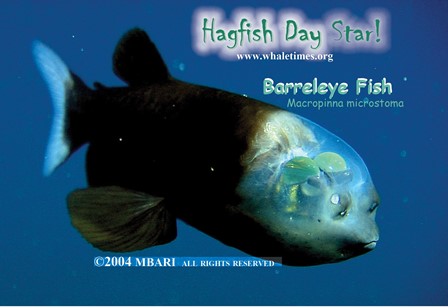Hagfish Day Star Expert Interview
Jeffrey Drazen and the Barreleye Fish (aka spookfish)
I shared a few questions with Dr. Jeffrey Drazen, a biologist who studies deep-sea fishes. He was kind enough to answer them to help us understand and appreciate this little incredible fish.
Jake, the SeaDog
Is the barreleye fish a newly discovered fish? 
JD: We have known about this fish for many years. However, most of the specimens were caught in trawls which damaged the specimens. The transparent dome on its head is a recent discovery made possible by using cameras and ROVs to observe the animals alive.
Dr. Drazen, what in the heck is going on with the spookfish’s head?
JD: The spookfish has a pair of tubular eyes like binoculars. The eyes are pointed upwards because in its deep-sea home, this is where all the light is coming from. The spookfish looks for shadows of things it could eat made against the very dim light coming from the sun above. Its eyes are very light sensitive but because of the tubes there is a very narrow field of view (What does that mean? Try looking through binoculars or even a pair of cardboard tubes from paper towels. Can you see anything off to the side without moving the binoculars? That’s a “narrow field of view.”)
What puzzled scientists for a long time was that the barreleye has a small mouth and its eyes pointed upward. How could it get food into its mouth? Then during a dive with a remotely operated vehicle (ROV) Dr. Bruce Robison observed this fish. At first its eyes were turned upwards as we had always seen them before. Then it did something amazing, its eyes pivoted, turning down so that they looked out in front! The big transparent dome allowed the eyes to move around and see at different angles! (How cool is that?)
Since I can see through its head, can I see it thinking?
JD: The transparent part is actually over the skull itself so nope you can’t easily see the brain.
Transparent head? Is this the weirdest animal in the sea? Are their other transparent animals?
JD: There are lots of transparent animals in the ocean. In the open ocean there are no rocks or seaweed to hide behind so being transparent is a great way to hide from predators. Baby fish, shrimp, and many plankton are transparent. Even some squids and, of course, the spookfish are transparent or have transparent parts of their bodies.
Why should it win the ugly-beauty contest?
JD: It may appear ugly but its beauty is in how well adapted this animal is to its habitat.
Is this a common deep sea fish? Is it threatened or endangered?
JD: This is not a very abundant fish but it is commonly found throughout the Pacific, Indian and Atlantic oceans. There are several different species.
What is the most amazing thing about barreleye?
JD: That it evolved a pair of very sensitive eyes and then overcame the narrow field of view by evolving a transparent dome. It can see and operate in extremely dim light – equivalent to a dark cloud covered night in the country.
How can I help barrel eyes, hagfish, and other deep-sea animals?
JD: You can help barreleyes and hagfish by reading about the them, watching wildlife shows about the deep-sea (like the Blue Planet series), and telling your friends and family about how interesting these animals are.
**A special thanks to Dr. Drazen for helping us celebrate Hagfish Day. Dr. Drazen’s research is supported by the National Science Foundation (BIO-OCE #0727135)
To learn more about the Barreleye,
- Visit WhaleTimes’ Barreleye Fish page
- Read about Dr. Robison’s barreleye discoveries